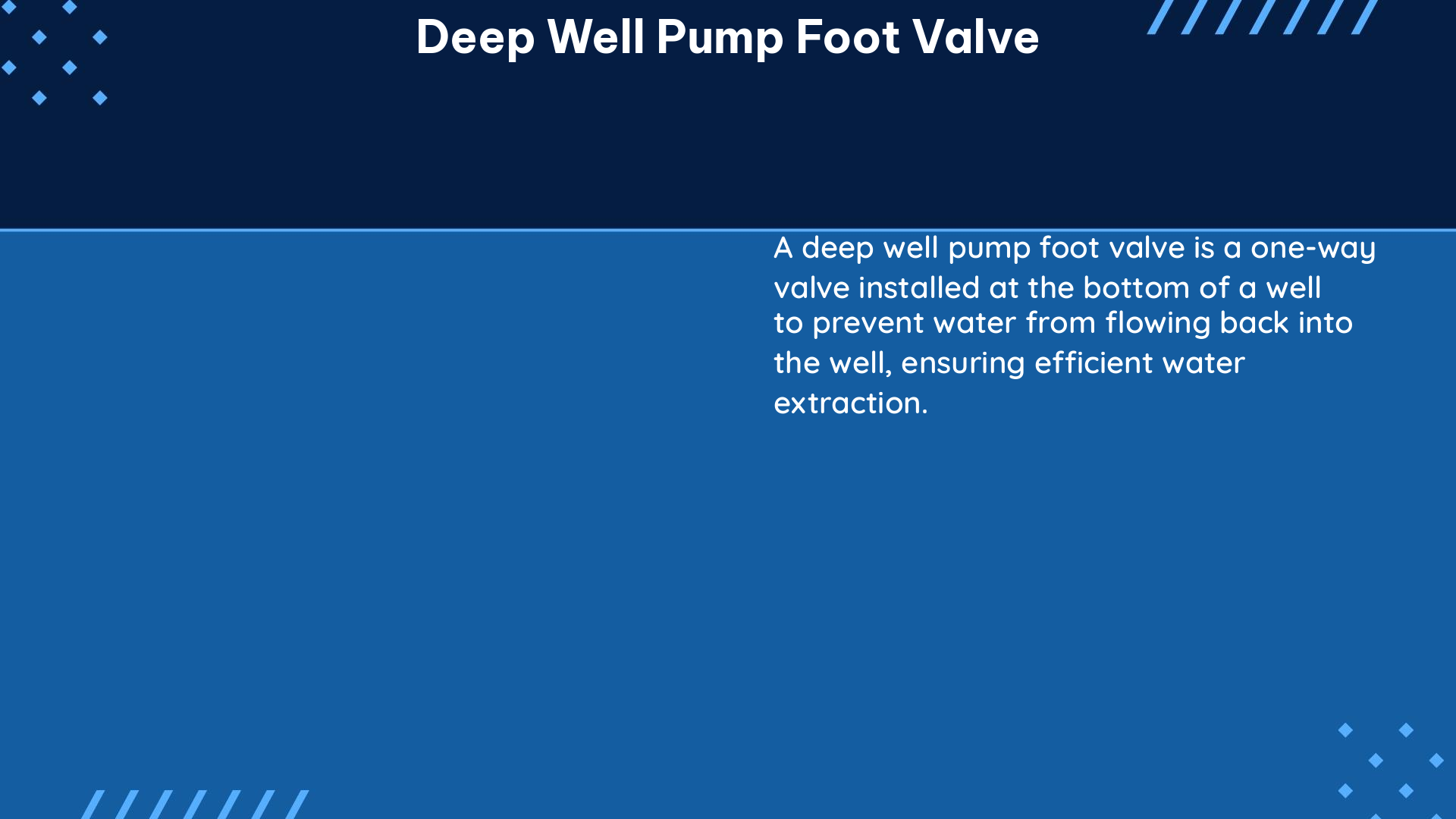Deep well pump foot valves are crucial components in well pumping systems, as they help prevent damage to the pump and keep it primed. These valves operate similarly to check valves, allowing media to flow in a single direction by closing if backflow occurs. The key feature of a foot valve is the strainer installed on its inlet port, which prevents large debris from entering the valve and potentially causing damage.
Understanding the Importance of Foot Valves
Foot valves play a vital role in maintaining the efficiency and longevity of deep well pumping systems. They serve several critical functions:
- Preventing Pump Damage: By preventing backflow, foot valves protect the pump from the potentially damaging effects of reverse flow, which can cause cavitation and other issues.
- Maintaining Priming: Foot valves help keep the pump primed, ensuring a consistent and reliable water supply.
- Preventing Backflow: These valves prevent water from flowing back into the well, which can lead to contamination and other problems.
Selecting the Right Foot Valve

When choosing a foot valve for a deep well pumping system, several factors must be considered:
Flow Rate
Foot valves work best at flow rates lower than 1.5 meters per second. Higher velocities can lead to cavitation and early failure of the valve. It’s essential to select a foot valve that can handle the specific flow conditions of the system.
System Pressure
The entire system’s pressure should be taken into account, not just the pump’s pressure setting. This ensures the foot valve can withstand the maximum pressure the system may experience.
Pipe Size vs. Valve Size
While the foot valve’s size should match the pipe size, it’s crucial to consider the correct size for the flow conditions, not just the pipe diameter. Oversizing or undersizing the foot valve can lead to performance issues.
Material Selection
Common materials for foot valves include heavy-duty cast iron, stainless steel, bronze, and PVC. Metal materials are more suitable for high-pressure applications, while PVC has internal pressure ratings up to 84 bar (1218 psi) and is non-corrosive, making it preferable for systems within its pressure rating.
Installation and Maintenance
Proper installation and regular maintenance are essential for the long-term performance of a deep well pump foot valve.
Installation
Before installing a well foot valve, it’s necessary to clean out any built-up sediment and ensure the inside portion of the valve is clear of foreign objects. During installation, the arrow on the valve should face towards the water flow (up), and it should be installed in a vertical position.
Maintenance
Well foot valves can experience issues such as wear and tear, clogging, or failure due to debris or sediment. Regular maintenance, including inspections, cleaning, and replacement of worn parts, is crucial to ensure the longevity and efficiency of the foot valve.
Foot Valves in Different Pump Systems
Foot valves are suitable for use in both shallow and deep wells, whether using a one- or two-line jet pump. Submersible pumps, on the other hand, typically use check valves instead of foot valves.
Troubleshooting Common Issues
Some common issues that can arise with deep well pump foot valves include:
- Clogging: Debris and sediment can accumulate in the foot valve, causing it to become clogged and impeding water flow.
- Wear and Tear: Over time, the foot valve’s components can wear down, leading to leaks, reduced performance, or even complete failure.
- Backflow: If the foot valve fails to close properly, it can allow water to flow back into the well, potentially causing contamination.
Addressing these issues through regular maintenance and prompt repairs is essential for maintaining the efficiency and reliability of the deep well pumping system.
Conclusion
Deep well pump foot valves are critical components that play a vital role in the performance and longevity of deep well pumping systems. By understanding the importance of these valves, selecting the right one for the application, and following proper installation and maintenance procedures, you can ensure your deep well pump continues to operate efficiently and reliably for years to come.
References:
- Recommended Standards for Water Works – 2012: https://www.health.state.mn.us/communities/environment/water/docs/tenstates/waterrev2012.pdf
- Deep-well jet pump that will not build pressure: https://www.doityourself.com/forum/forum/showthread.php?t=644989
- Well Pump Foot Valve: https://www.hearth.com/talk/threads/well-pump-foot-valve.73300/
- Well Foot Valve: https://tameson.com/pages/well-foot-valve
- Foot Valves Explained – YouTube: https://www.youtube.com/watch?v=THB8vDgANKQ

The lambdageeks.com Core SME Team is a group of experienced subject matter experts from diverse scientific and technical fields including Physics, Chemistry, Technology,Electronics & Electrical Engineering, Automotive, Mechanical Engineering. Our team collaborates to create high-quality, well-researched articles on a wide range of science and technology topics for the lambdageeks.com website.
All Our Senior SME are having more than 7 Years of experience in the respective fields . They are either Working Industry Professionals or assocaited With different Universities. Refer Our Authors Page to get to know About our Core SMEs.